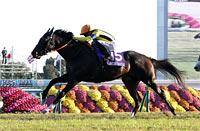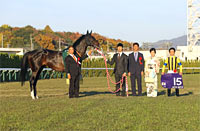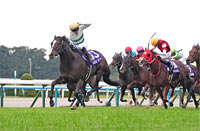Mile Championship (G1) - Data Analysis
Autumn mile champion decider
The Mile Championship is a mile-long G1 race contested on the outer oval 1,600m turf track of Kyoto Racecourse. Many of its winners have gone on to become stallions or a broodmares after retirement, passing on their speed to future generations. Let’s now look at some trends in this race based on data from the last 10 years, including the period from 2020 to 2022, when the race was held at Hanshin Racecourse.
Closely matched performance among highly favored runners
Looking at performances by runners over the last 10 years in terms of favoritism, we find that runners backed as 5th favorite or higher achieved more or less similar Top 3 ratio of 40.0-50.0%. We can therefore conclude that highly favored runners deliver comparable performance. Although Win ratios start dropping for runners backed as 6th favorite or lower, eight runners in this group have also finished in the Top 3 over the last 10 years. [Table 1]
[Table 1] Performance by favoritism (last 10 years)
| Favoritism |
Performance
[1st-2nd-3rd-4th or lower] |
Win ratio |
Top 2 ratio |
Top 3 ratio |
| 1st favorite |
2-1-1-6 |
20.0% |
30.0% |
40.0% |
| 2nd favorite |
0-4-1-5 |
0% |
40.0% |
50.0% |
| 3rd favorite |
2-3-0-5 |
20.0% |
50.0% |
50.0% |
| 4th favorite |
3-0-1-6 |
30.0% |
30.0% |
40.0% |
| 5th favorite |
2-0-2-6 |
20.0% |
20.0% |
40.0% |
| 6th favorite or lower |
1-2-5-114 |
0.8% |
2.5% |
6.6% |
Looking at performances by runners in terms of win odds, we note that in terms of betting value, our focus among the highly favored runners should be on those with win odds between 4.0 and 9.9. Runners falling in this group have finished in the Top 2 in each of the last 10 years, so it would seem advisable to pick from within this odds range. Meanwhile, the 76 runners with low favoritism (win odds of 50 or more) have produced zero Top 3 finishers. [Table 2]
[Table 2] Performance by win odds (last 10 years)
| Win odds |
Performance
[1st-2nd-3rd-4th or lower] |
Win ratio |
Top 2 ratio |
Top 3 ratio |
| 3.9 or lower |
2-1-1-8 |
16.7% |
25.0% |
33.3% |
| 4.0-9.9 |
7-7-2-17 |
21.2% |
42.4% |
48.5% |
| 10.0-19.9 |
1-1-5-17 |
4.2% |
8.3% |
29.2% |
| 20.0-49.9 |
0-1-2-24 |
0% |
3.7% |
11.1% |
| 50.0 or higher |
0-0-0-76 |
0% |
0% |
0% |
Runners starting in the outer brackets have a slight advantage
Looking at performances by runners in the seven races held at Kyoto Racecourse over the last 10 years in terms of bracket number, we find that runners starting in Bracket 8 achieved a Top 2 ratio of 25.0%, with four victories, while runners starting in Bracket 7 achieved a Top 3 ratio of 22.2%. This suggests that runners starting in the outer brackets deliver higher success ratios. In last year’s race, the Top 3 was occupied exclusively by runners starting in Brackets 7-8, with Soul Rush (Bracket 7, number 13) claiming the victory, Elton Barows (Bracket 8, number 17) finishing 2nd, and Win Marvel (Bracket 7, number 14) placing 3rd. [Table 3]
[Table 3] Performance by bracket number (2015-2019, 2023, 2024)
| Bracket number |
Performance
[1st-2nd-3rd-4th or lower] |
Win ratio |
Top 2 ratio |
Top 3 ratio |
| 1 |
1-2-0-11 |
7.1% |
21.4% |
21.4% |
| 2 |
0-0-2-12 |
0% |
0% |
14.3% |
| 3 |
1-0-2-11 |
7.1% |
7.1% |
21.4% |
| 4 |
0-1-1-12 |
0% |
7.1% |
14.3% |
| 5 |
0-1-0-13 |
0% |
7.1% |
7.1% |
| 6 |
0-1-0-13 |
0% |
7.1% |
7.1% |
| 7 |
1-1-2-14 |
5.6% |
11.1% |
22.2% |
| 8 |
4-1-0-15 |
20.0% |
25.0% |
25.0% |
Runners coming from a G1 race fare well
Looking at performances by runners over the last 10 years in terms of their previous race, we find that runners coming from a G1 race achieved the highest success ratios. Those coming from the Sprinters Stakes, the Tenno Sho (Autumn), or the Yasuda Kinen warrant particular attention. Runners coming from a G2 race also turned in decent performance, while runners coming from the Fuji Stakes or Mainichi Okan—the major prep races—have similarly delivered notable performances. [Table 4]
[Table 4] Performance by previous race (last 10 years)
| Previous race |
Performance
[1st-2nd-3rd-4th or lower] |
Win ratio |
Top 2 ratio |
Top 3 ratio |
| G1 |
4-2-3-21 |
13.3% |
20.0% |
30.0% |
| G2 |
5-4-7-72 |
5.7% |
10.2% |
18.2% |
| G3 |
1-4-0-38 |
2.3% |
11.6% |
11.6% |
| Non-graded |
0-0-0-9 |
0% |
0% |
0% |
| NAR or overseas |
0-0-0-2 |
0% |
0% |
0% |
Check the finish in the previous race
Looking at performances by runners over the last 10 years in terms of finish in their previous race, we observe that 29 of the 30 Top 3 finishers had finished in the Top 5 of their previous race. Incidentally, runners that had been beaten to 6th or lower in their previous race included runners that were highly favored in the Mile Championship such as Schnell Meister, who finished 5th as race favorite in 2022, and Salios, who finished 6th in 2021 while backed as 3rd favorite. We should therefore check performance in the previous race. [Table 5]
[Table 5] Performance by finish in previous race (last 10 years)
| Finish in previous race |
Performance
[1st-2nd-3rd-4th or lower] |
Win ratio |
Top 2 ratio |
Top 3 ratio |
| 1st, 2nd |
7-6-3-41 |
12.3% |
22.8% |
28.1% |
| 3rd-5th |
3-4-6-39 |
5.8% |
13.5% |
25.0% |
| 6th or lower |
0-0-1-62 |
0% |
0% |
1.6% |
Seek out the winner!
Track record in G1 or mile-long graded races is key
The last 10 winners all had experience of finishing in the Top 2 of a G1 race. In addition, nine of the 10 winners had experience of winning a mile-long G2 and G3 race. In other words, a runner with a decent track record in mile-long race to date is likely to be the first to dash past the Kyoto finish post this autumn, which is only fitting for a race that bears the name “Championship.” [Table 6]
[Table 6] Winners’ performance in G1 or mile-long graded races (last 10 years)
| Year |
Winner |
Performance in major G1 race |
Wins in mile-long
G2 or G3 races |
| 2015 |
Maurice |
Yasuda Kinen, 1st |
1 |
| 2016 |
Mikki Isle |
NHK Mile Cup, 1st |
2 |
| 2017 |
Persian Knight |
Satsuki Sho (Japanese 2000 Guineas), 2nd |
1 |
| 2018 |
Stelvio |
Asahi Hai Futurity Stakes, 2nd |
0 |
| 2019 |
Indy Champ |
Yasuda Kinen, 1st |
1 |
| 2020 |
Gran Alegria |
G1, 3 wins |
1 |
| 2021 |
Gran Alegria |
G1, 5 wins |
1 |
| 2022 |
Serifos |
Asahi Hai Futurity Stakes, 2nd |
3 |
| 2023 |
Namur |
Shuka Sho, 2nd |
2 |
| 2024 |
Soul Rush |
Mile Championship, 2nd |
3 |
(Yodohito Himezono)
|




















